Hey there, pool owners and fellow water enthusiasts! Are you tired of spending hours skimming leaves, scrubbing algae, and trying to keep your pool pristine? Well, it’s time to dive into the future of pool maintenance with robotic pool cleaners! These sleek, high-tech gadgets are here to make your pool maintenance a breeze, allowing you to sit back, relax, and truly enjoy your pool. In this ultimate guide, we’ll cover everything you need to know about robotic pool cleaners, from choosing the right one for your pool to using and maintaining it like a pro.
Why Go Robotic?
First things first, why should you choose a robotic pool cleaner over other options? Well, let me tell you, these little wonders are an entirely different league when it comes to efficiency and effectiveness. Unlike traditional pool cleaning methods that rely on your pool’s pump and filter system, robotic pool cleaners operate independently, giving your pool pump a much-needed break. They are equipped with advanced features and smart technology, ensuring thorough cleaning and leaving your pool water sparkling clean. Plus, they are energy-efficient and require minimal human intervention, saving you precious time and effort.
Types of Robotic Pool Cleaners
There’s no one-size-fits-all when it comes to robotic pool cleaners. Different models offer various features to cater to specific pool sizes and cleaning needs. Here are the main types you’ll come across:
1. Suction-Side Robotic Pool Cleaners
These cleaners use the suction power of your pool pump to move around and pick up debris. They are an affordable option, but keep in mind that they may add strain to your pool pump and filtration system.
2. Pressure-Side Robotic Pool Cleaners
Pressure-side robotic cleaners utilize the pressure from your pool’s return jets to propel themselves. They are excellent for removing larger debris like leaves and pebbles, but they may require an additional booster pump to function optimally.
3. Robotic Pool Cleaners with Power Brushes
For pools with stubborn dirt and algae, robotic cleaners with power brushes are your best bet. These brushes scrub away dirt and grime while the cleaner’s vacuum sucks up the debris, leaving your pool floor and walls spotless.
4. Hybrid Robotic Pool Cleaners
If you can’t decide between a suction-side and pressure-side cleaner, go for the best of both worlds—hybrid robotic pool cleaners. These versatile units can operate as both suction-side and pressure-side cleaners, offering flexible cleaning options.

Factors to Consider When Choosing a Robotic Pool Cleaner
Choosing the right robotic pool cleaner involves evaluating several factors to ensure it meets your pool’s unique needs. Here’s what you should consider:
1. Pool Size and Shape
The size and shape of your pool play a crucial role in determining the ideal cleaner. Some models are better suited for small, simple-shaped pools, while others excel in larger or more complex pools.
2. Cleaning Features
Different robotic pool cleaners offer various cleaning features, such as scrubbing brushes, multiple cleaning cycles, or programmable timers. Assess which features align with your pool’s cleaning requirements.
3. Filter Type
Robotic pool cleaners come with different filter types, such as cartridge filters or bag filters. Cartridge filters are easy to clean but may require more frequent maintenance, while bag filters are ideal for capturing finer debris.
4. Energy Efficiency
Look for energy-efficient models with advanced technology that consumes less electricity while delivering effective cleaning performance. Opting for an energy-efficient robotic cleaner saves you money in the long run.
5. Cable Length and Tangle Prevention
Consider the length of the cleaner’s cable to ensure it can cover your entire pool. Additionally, features like anti-tangle swivels prevent the cable from getting twisted during operation.
6. Warranty and Customer Support
Investing in a high-quality robotic pool cleaner is essential. Check for a reliable warranty and accessible customer support to resolve any issues that may arise.
Setting Up Your Robotic Pool Cleaner
Excited to give your pool a robotic cleaning makeover? Let’s get your cleaner up and running:
1. Inspect and Clean the Pool
Before deploying your robotic pool cleaner, give your pool a once-over and remove any large debris or obstacles that may hinder the cleaner’s operation.
2. Connect the Cleaner
Next, connect the robotic cleaner to a power source and ensure that all connections are secure. Follow the manufacturer’s instructions for the specific setup of your model.
3. Program the Cleaner
Some robotic pool cleaners come with programmable features, allowing you to customize the cleaning schedule to your preferences. Set the cleaning cycle duration and frequency as needed.

Using Your Robotic Pool Cleaner Effectively
Congratulations, your robotic pool cleaner is now ready to work its magic! Here are some tips to use it effectively:
1. Pool Cleaning Schedules
Determine the ideal cleaning schedule based on your pool’s usage and the surrounding environment. Regular cleaning sessions keep your pool consistently clean and reduce the strain on the cleaner.
2. Supervising the Cleaner
While robotic pool cleaners are generally safe to operate unsupervised, it’s essential to keep an eye on the cleaner during the first few cleaning cycles to ensure optimal performance.
3. Removing and Cleaning the Filter
After each cleaning session, remove and clean the filter or debris bag, depending on your model. Proper maintenance ensures the cleaner operates at its best and prolongs its lifespan.
Maintenance and Care Tips
Robotic pool cleaners are low-maintenance, but a little care goes a long way in keeping them in top shape:
1. Regular Cleaning of Filter and Debris Bag
Clean the filter or debris bag after each use to prevent clogging and ensure the cleaner’s efficiency during future cleaning cycles.
2. Checking Brushes and Wheels
Inspect the cleaner’s brushes and wheels for any signs of wear or damage. Replace or repair these components as needed to maintain optimal cleaning performance.
3. Storage and Winterizing
When not in use, store your robotic pool cleaner in a cool, dry place away from direct sunlight. If you live in a colder climate, follow the manufacturer’s guidelines for winterizing your cleaner.
Common Troubleshooting Tips
Occasionally, your robotic pool cleaner might encounter minor hiccups. Here are some common troubleshooting tips:
1. Cleaner Not Moving
Check for obstructions in the impeller or around the wheels. Clear any debris that may be causing the issue.
2. Cable Tangling
Ensure the cleaner’s cable is free from tangles and knots. Use an anti-tangle swivel if your cleaner is equipped with one.
3. Obstructed Impeller or Filter
If the cleaner is not picking up debris effectively, check and clean the impeller or filter as they may be clogged.
Conclusion
There you have it—a comprehensive guide to robotic pool cleaners! From understanding the different types to selecting the perfect cleaner for your pool and effectively using and maintaining it, you’re now equipped to take the plunge into a hassle-free pool cleaning experience.
So, why keep struggling with pool maintenance when you can sit back, relax, and let the robot do the work? Upgrade your pool cleaning game with a robotic pool cleaner from Calcium killers today. Give it some thought. We sell the best at an affordable price. Reach out to us.
